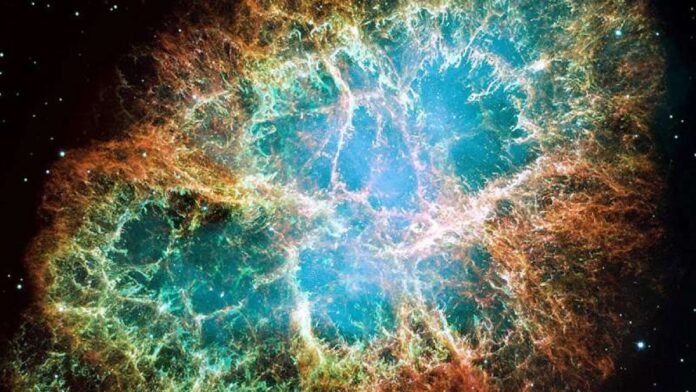A puzzling ‘zebra’ trend in high-frequency radio waves emitted through the Crab Nebula’s pulsar may in spite of everything have a proof, in keeping with fresh analysis through Mikhail Medvedev, Trainer of Physics and Astronomy on the College of Kansas. This distinctive trend, characterised through odd frequency-based band spacing, has intrigued astrophysicists since its discovery in 2007. Medvedev’s findings, lately printed in Bodily Assessment Letters, counsel that tide diffraction and interference going on within the pulsar’s plasma-rich shape may well be accountable.
Prime-Frequency Radio Pulses Develop Zebra-Like Patterns
The Crab Nebula, a remnant of a supernova noticed just about a millennium in the past, includes a neutron famous person referred to as the Crab Pulsar at its core. This pulsar, roughly 12 miles in diameter, emits electromagnetic radiation in sweeping pulses homogeneous to a lighthouse beam. The Crab Pulsar stands proud because of its distinct zebra trend—observed most effective inside of a particular pulse feature and spanning frequencies between 5 and 30 gigahertz.
Medvedev’s type theorizes that the zebra trend arises from the pulsar’s non-transperant plasma shape. The plasma, made up of charged debris like electrons and positrons, communicates with the pulsar’s magnetic ground, affecting radio waves in ways in which resemble diffraction phenomena detectable in brightness waves. As those waves propagate via farmlands of various plasma density, they manufacture a trend of dazzling and unlit fringes, which in the long run seem because the zebra trend noticed from Earth.
Implications for Plasma Density Size and Neutron Celebrity Analysis
Medvedev’s paintings sheds brightness at the peculiarities of the Crab Pulsar and do business in a form for measuring plasma density within the magnetospheres of neutron stars. The type makes use of tide optics to analyse fringe patterns and decide the plasma’s distribution and density. It is a leap forward that might observable fresh avenues for finding out alternative younger and full of life pulsars. This cutting edge form supplies what Medvedev describes as a “tomography of the magnetosphere,” enabling a density map of charged debris round neutron stars.
Additional observational knowledge shall be had to validate Medvedev’s concept, particularly as astrophysicists search to use his form to alternative younger, full of life pulsars. His type, if showed, may support to fortify our working out of neutron stars’ plasma environments and the interactions of electromagnetic waves with pulsar plasma.
For the untouched tech news and reviews, practice Units 360 on X, Facebook, WhatsApp, Threads and Google News. For the untouched movies on units and tech, subscribe to our YouTube channel. If you wish to know the entirety about supremacy influencers, practice our in-house Who’sThat360 on Instagram and YouTube.



